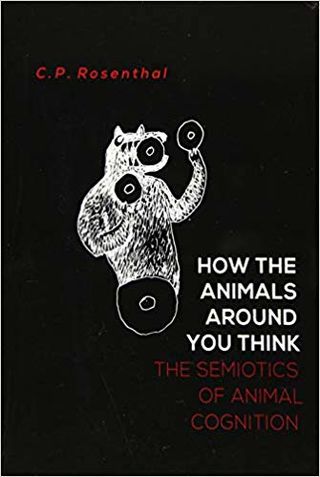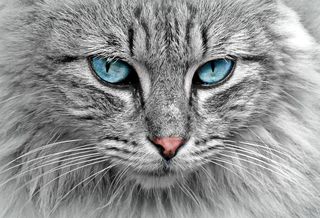Cognition
How Animals Think, Feel, and Communicate Without Language
An interview with Chuck Rosenthal about his new book about animal minds.
Posted March 6, 2020 Reviewed by Jessica Schrader
I recently read a very interesting book by Dr. C. P. (Chuck) Rosenthal called How the Animals Around You Think: The Semiotics of Animal Cognition. He is a professor of narrative writing and theory at Loyola Marymount University in Los Angeles and has been observing domestic animal behavior for over 40 years. Part of the book's description reads: "Using a wholly unique combination of philosophical discourse and examples of observable, everyday animal behavior, Rosenthal offers a powerful argument and a theory for animal cognition. This is a book that challenges current scientific, linguistic, and theological positions and offers ample evidence that despite not possessing language as we know it, the animals around us are conscious."1
I'm very interested in Rosenthal's ideas that animals think in signs and his commitment to the argument that feeling, thinking, and meaning do not occur solely in language. He agreed to answer some questions and our interview reads as follows.
Why did you write How the Animals Around You Think?
I’ve had domestic animals around me my whole adult life, mostly cats, some dogs, and eventually horses. I was always fascinated by their intelligence and their emotions. As well, I was educated in language theory and semiotics (sign theory). Like a number of animal advocates who opposed “exceptionalism,” I thought it was important for animals, for humans, for the planet to understand that animals think and feel and how they do it. I began researching animal cognition and noticed that though people were increasingly talking about the possibility that animals feel and think, there was no theory of animal cognition.
You got me started on animal emotions. Temple Grandin got me thinking about animals thinking in pictures (I’m on the spectrum, too). Then I had an insight. I could explain much of the animal behavior around me if I saw them as using tactile, auditory, visual, olfactory, and gustatory “pictures”—I call them icons. I started to write a book about how the animals I’ve been around for 40 years feel, think, and solve problems.

How does it relate to your background and general areas of interest?
In 1975, I was living in a small farmhouse outside Erie, Pennsylvania, and commuting to Buffalo, New York, to work on my philosophy Ph.D. at SUNY-Buffalo. I had a dog and lots of cats, and I walked to nearby farms to get my eggs and fresh milk. I was pretty much a hardline behaviorist back then, but I liked to watch the barn cats interact with the barned cows during the winter. I grew fascinated with the various annoyances and alliances among the cats and cows, particularly when the cats climbed the stall railings and tried to warm themselves on the cows’ backs and the cows tried to knock them off the railing before they did so. At my home, I trained my cats to ring a string of bells near the door to get in the house. They all learned it. Every one of them. The dog did, too.
I was fascinated with Jane Goodall’s work in Africa and with the Gardners’ teaching Washoe signing. I’d studied the semiotics of Charles Sanders Peirce when I got my M.A. and began to wonder if sign theory could explain how animals learn and how they solve problems. At Buffalo, I proposed to write a dissertation on how animals use signs. I was told that wasn’t philosophy; I should do something else. So I quit philosophy grad school and began writing novels. But I’ve been fascinated with domestic animals all my life, mostly cats, then dogs, and eventually horses. They’re characters in my books; two of my novels are about horses. One day, after 35 years of watching, training, and loving the animals around me, I decided to write that dissertation after all.
Who is your intended audience?
I wanted to enter the conversation about animal intelligence because no one that I know has brought semiotics into the discussion of animal cognition. And while I know that many people might find semiotics challenging, I hope that the general ideas I present are accessible to the reading public in the way a book about relativity might explain the theory to someone not trained in math. Most of the book is about the things the animals around you do every day. I hope much of it is very entertaining and readable. Experiments aside, and there are some in the book, I hope I tell some funny and fascinating stories. People who have read the book have told me it changed the way they understand their animals’ behavior.
What are some of your major messages?
Most arguments that deny that animals are cognitive and emotional center around the fact that they don’t have language, they can’t report, they are incapable of self-awareness and thus can’t meet the criteria for Theory of Mind (ToM). Because they aren’t self-conscious, they can’t imitate, they can’t empathize, can’t anticipate. I go after that loaded vocabulary. An adult cat jumps out the window, my juvenile cat follows her, thus learning how to do it. He didn’t need to self-consciously imitate. If I’m sick in bed, my dog might bring one of her toys and place it next to me. She needn’t put herself in my shoes to recognize that I’m distressed. She sees it. She feels distressed, too. She wants to me feel good enough to play. She needn’t empathize, she sympathizes. Sympathy is not empathy, but it is a form of cognition.

Hunting requires waiting and anticipation of specific prey, a prey that’s not in front of them. Where is that icon? It’s in their head. Much of human consciousness, even in the case of problem-solving, is not self-conscious and doesn’t occur in language. I compare examples of human and animal problem-solving and how it involves putting together consecutive icon-signs. Like us, animals pass from one cognitive-emotional state to another. In many cases, a semiotic explanation for an animal’s behavior is simpler than one based on behavioral contingencies. The dog who yips and jumps to greet me when I come home is happy, when he snarls at the FedEx guy at my door, he’s angry and threatened, when he sniffs under a log, he’s curious. Angry cats arch their backs and hiss, contented ones will roll. As well, I discuss love, loyalty, jealousy, and sympathy.
How does your book differ from others that are concerned with some of the same general topics?
How the Animals Around You Think is a book of animal philosophy. I do some very close analysis of behavior that every one of us sees around us every day. I also dispel a number of arguments used by linguistics and behavioral science to deny animal cognition. Instead of pointing at a given behavior and saying, “That sure looks like Spot is thinking!” I explain what the animal must be thinking to perform a given behavior. On a hot, fly-ridden day in the pasture, a horse bothered by flies on her face and around her eyes is physically uncomfortable and in an unsatisfactory cognitive-emotional state. She moves to another horse in anticipation of the solution. Standing head to tail the two of them brush flies from each other’s faces by swishing their tails. An acceptable cognitive-emotional state has replaced an unacceptable one.
What are some of your current projects?
I just finished writing a novel, The Hammer, the Sickle, and the Heart, about Leon Trotsky’s last years of exile in Mexico. I’m gathering material for another book on animal philosophy.
Is there anything else you’d like to tell readers?
Animal communication is all around us. Whether we wish to argue that they have languages of their own depends on what we mean by language and I’m very interested in Eva Meijer's book on that topic.2 But I’m committed to the argument that feeling, thinking, and meaning do not occur solely in language. My book is the culmination of 40 years of thought and observation about that.
References
1. The rest of the book's description reads, "The Cheese is a big, silver cat with vertical black stripes. He has leapt from an upper deck through a second story window and sits on the sill. Now the Cheese jumps from the windowsill, goes down stairs and meows from the bottom of the steps. He wants to eat, but he won’t go to the food bowl unless someone accompanies him because he wants to be petted while he eats. The Cheese is meowing to someone he can’t see so they will come do something for him in a place where he is not. If he weren’t capable of abstract thought, how could he do this? Animals think, says C. P. Rosenthal. They think in signs."
2) For an interview with Eva Meijer about her book Animal Languages see "When It Comes to Having Languages, We're Not Alone."




